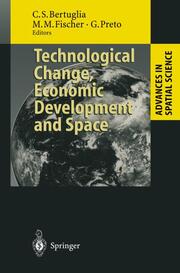Detailansicht
Technological Change, Economic Development and Space
Advances in Spatial Science
ISBN/EAN: 9783642797620
Umbreit-Nr.: 4379986
Sprache:
Englisch
Umfang: xvi, 354 S.
Format in cm:
Einband:
kartoniertes Buch
Erschienen am 14.12.2011
Auflage: 1/2011
- Zusatztext
- Inhaltsangabe1. Technological Change, Economic Development and Space: An Introduction.- 1.1 The Context.- 1.2 The Structure of the Book.- References.- A: Diffusion of Knowledge, Network Externalities and Economic Development.- 2. Creation, Innovation and Diffusion of Knowledge: General and Specific Economic Impacts.- 2.1 Fast and Slow Processes of Development.- 2.2 Creativity, Innovation and Diffusion.- 2.3 The Creative Process.- 2.4 Small Scale Creative Cooperation.- 2.5 Productivity versus Creativity: ASocial Conflict.- 2.6 Research and Development, Innovations and Patenting.- 2.7 Dynamics of Merger in Knowledge Intensive Markets.- 2.8 Slow Processes of Knowledge and Networks and the Size and Structure of Dominant Regions.- 2.9 Some Historical Evidence.- 2.10 The Emerging C-Society and C-Regions of the Future.- 2.11 Small Plants and Large Corporations.- 2.12 New Macro C-corridors in Europe, the US and Japan.- 2.13 Summary and Conclusions.- References.- 3. A Territorial Socio-ecological Approach to Innovation Diffusion, Schumpeterian Competition and Dynamic Choice.- 3.1 Introduction.- 3.2 Characterization of the Territorial Environment: Territorial Decentralized Systems, the Superposition Principle and the Phenomenon of Unilinear Evolution.- 3.3 From the Concept of 'Homo Economicus' to the Concept of 'Homo Socialist' Innovation Diffusion as a Collective Socio- ecological Dynamic Choice Process.- 3.4 Diffusion of One Innovation within a Territorial Unit: A Reinterpretation of Verhulst and Pearl-Reed Logistic Differential Equations.- 3.5 A Mathematical Model of the Diffusion of a Cluster of Competitive Innovations within an Active Territorial Environment: The Creation of Innovation Adoption Niches.- 3.6 Qualitative Analysis of Results of the Dynamic Competition Hypergame for Diffusion of Clusters of Competitive Innovations: Schumpeter Competition Cycles.- 3.7 Variational Principle for Dynamic Competition Hypergames: Law of Collective Meso-level Choice Behaviour.- 3.8 Conclusions: Competition and Environment in the Innovation Diffusion Process.- References.- 4. Innovation, Communication Networks and Urban Milieus: A Sociological Approach.- 4.1 Introduction.- 4.2 Phases of the Innovation Process and Resources.- 4.3 Innovation as the Output of Communication Networks.- 4.4 A Typology of Innovative Contexts.- 4.5 Conclusions.- References.- 5. Transportation, Communications and Patterns of Location.- 5.1 Introduction.- 5.2 Present Trends and Emerging Problems.- 5.3 A Conceptual Framework for the Analysis of Location - Transport Systems.- 5.4 The Spatial Implications of Technological Innovation in Communication Networks.- 5.5 Fields of Application.- 5.6 Conclusions.- References.- 6. The Interacting Choice Processes of Innovation, Location and Mobility: A Compartmental Approach.- 6.1 Introduction.- 6.2 The Conceptual and Methodological Background.- 6.3 The Choice Processes Involved in Innovation Adoption.- 6.4 The Location Choice Process.- 6.5 The Modal Choice between Transport and NIT.- 6.6 The Pattern of Flows.- 6.7 The Structure of the Telemaco Model.- 6.8 Conclusions.- Acknowledgements.- References.- B: Innovation Behaviour of Individual Firms.- 7. Technological Change and Innovation Behaviour.- 7.1 Introduction.- 7.2 A Conceptual Model of the Technological Innovation Process.- 7.3 Factors Influencing Innovation Behaviour.- 7.4 Summary and Conclusions.- References.- 8. Company Classification and Technological Change: A New Perspective on Regional Innovation.- 8.1 Introduction.- 8.2 Company Classification.- 8.3 Technological Profiles of Establishment Types.- 8.4 Implications for Regional Analysis.- 8.5 Conclusions.- Acknowledgements.- References.- 9. Innovation Adoption, Innovation Networks and Agglomeration Economies.- 9.1 Introduction.- 9.2 Networks and Innovation Adoption.- 9.3 Agglomeration Economies, Innovation Networks and Innovation Adoption.- 9.4 Innovation Networks and the Adoption and Diffusion of Information Technology: Some Empiri
